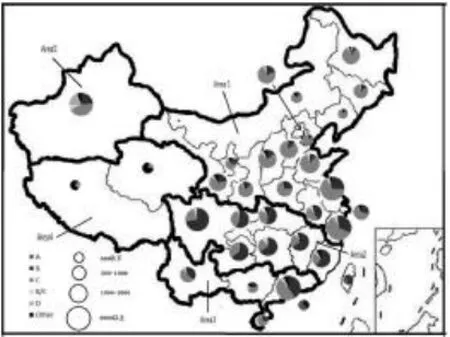中国慢性HBV感染者基因型分布及其临床意义Meta分析*
伍宵,魏少峰,徐楠,苏倩,李旭,张振华
·病毒性肝炎·
中国慢性HBV感染者基因型分布及其临床意义Meta分析*
伍宵,魏少峰,徐楠,苏倩,李旭,张振华
目的探讨中国乙型肝炎病毒(HBV)基因型分布及其临床意义。方法在万方数据库和NCBI数据库检索有关中国HBV基因型分布的研究论文,将中国分为不同HBV感染流行区,分析不同地区、民族和肝脏疾病类型人群HBV基因A、B、C、B/C、D型和其他基因型(非A~D基因型和非B/C混合型)分布。采用Meta分析基因型分布特点及其临床意义。结果在我国,HBV基因型主要以B基因型和C基因型为主,区域1(北部地区)HBV基因A、B、C、B/C、D型和其他型分别为0.1%、22.2%、69.1%、3.8%、0.5%和1.5%,其中C基因型比例显著高于其它区域(P<0.05);区域2(中部地区)HBV基因A、B、C、B/C、D型和其他型分别为0.2%、62.6%、27.4%、3.8%、0.5%和2.4%,其中B基因型比例显著高于其它区域(P<0.05);区域3(南部地区)HBV基因A、B、C、B/C、D型和其他型分别为0.6%、36.3%、49.4%、2.8%、2.6%和3.4%,其中C基因型比例显著高于区域2的27.4%(P<0.05);区域4(青藏高原)感染HBV B基因型、C基因型、D基因型和其他基因型分别为6.0%、22.5%、11.7%和59.3%,其中C/D混合型比例显著高于其他区域(P<0.05);藏族人群C/D混合型比例(49.3%)显著高于其他民族(P<0.05),哈萨克族D基因型比例(58.1%)显著高于其他民族(P<0.05);C基因型与慢性乙型肝炎、HBV相关性肝硬化和肝癌显著相关(OR=1.979、OR=3.888、OR=4.399,P<0.001)。结论不同地区和民族HBV基因型分布显著不同,B基因型可能是中国HBV起源基因,而感染C基因型更有可能引起严重的肝脏疾病。
乙型肝炎;基因型;民族;分布
全球有2.4亿人为慢性乙型肝炎病毒(HBV)感染者[1-3],2006年全国流行病学调查表明中国人HBsAg阳性率为7.2%[4]。根据HBV全基因核苷酸序列异质性≥8%,或者S基因核苷酸序列≥4%,可将HBV分为A~J十种基因型[5-7],部分基因型还可以根据全基因核苷酸序列的差异在4%~8%之间分为基因亚型[8]。HBV基因型/亚型的地理分布差异明显,如基因型A在非洲和欧洲常见,基因型B和基因型C流行于东亚,D基因型发现于地中海地区和西亚,E基因型在西方撒哈拉以南区域多见,F基因型常见于美国土著人[9,10],G基因型在法国和美国,H基因型和I基因型发现于中美洲、越南、老挝和中国,J基因型在琉球群岛和日本普遍[11]。HBV感染后可发生急性乙型肝炎(AHB)、慢性乙型肝炎(CHB)、肝硬化(LC)、肝细胞癌(HCC)、肝衰竭(HF)等,但是不同基因型对HBV感染的进程影响不同,C基因型感染可能与肝硬化和肝恶性肿瘤的发生发展相关[12-14]。本研究对国内外相关文献进行了Meta分析,以探究中国HBV基因型分布及其临床意义。
1 资料与方法
1.1 数据收集检索万方数据库(http://www. wanfangdata.com.cn/)和NCBI数据库(http://www. ncbi.nlm.nih.gov/pubmed)自2000年至2014年有关中国HBV基因型感染分布的文献,检索词有:乙型肝炎病毒、基因型、民族、中国或hepatitis B virus, genotypes,nationalities,China。纳入标准:①关于中国HBV基因型的分布或检测;②明确指出HBV感染患者的所属省、市或自治区;③明确表明HBV感染患者的所属民族和临床类型;④香港、澳门和台湾的HBV基因型分布。排除标准:①HBV感染者的所属地区不明确;②非中国人群HBV感染;③合并慢性丙型肝炎或人类免疫缺陷病毒感染;④数据重复的文献或评论。
1.2 数据分类根据地区、民族和肝脏疾病类型的不同,将不同基因型的分类输入Office 2007中,HBV基因型分为A、B、C、B/C、D和其他基因型(非A~D基因型和非B/C混合型)。
1.3 数据分析应用STATA 12.0统计软件包,对不同地区和民族HBV感染基因型分布采用横断面研究的Meta分析。当比值比较大(如0.8<P<1.0)或比较小(0<P<0.2)者占多数时,采用双反正弦转换法;针对不同HBV感染类型的基因型分布应用二分类变量的Meta分析,P值小于0.05表示异质性大,采用随机效应模型,相反,P值大于0.05,采用固定效应模型,OR值>1表明C基因型与疾病发生的风险可能呈正相关,OR值越大,可能风险越大。计数资料采用例数和百分比表示,应用SSPS 13.0软件进行x2检验,P<0.05为差异有统计学意义。根据31个省、市、自治区、香港、澳门特别行政区和台湾省的人口数和HBV感染率[4,15,16],估算出不同基因型数量,由此估算出中国乙型肝炎感染的总人口数。
2 结果
2.1 检索情况从万方数据库和NCBI数据库检索出560篇关于HBV基因型感染的原始文献,其中220篇符合纳入标准被纳入。203篇文献涉及不同地区HBV基因型分布,116篇文献涉及不同临床型患者HBV基因型分布,21篇文献涉及不同民族HBV基因型分布,有关澳门HBV基因型的文章数量极少,本文未予以统计分析。
2.2 中国不同地区HBV基因型分布根据HBV基因型的分布特点,可以将中国分为五个HBV感染区域,区域1包括北京、上海、河北、内蒙古、山西、天津、黑龙江、吉林、辽宁、陕西、安徽、山东、甘肃、河南、江苏、浙江、宁夏;区域2包括四川、重庆、江西、湖南、湖北、福建、贵州、台湾;区域3包括海南、广西、广东、云南、香港;区域4为西藏、青海;区域5为新疆。在新疆地区,HBV基因型分布明显不同于其他地区(图1)。区域1 C基因型比例(69.1%)显著高于区域2的27.4%(P<0.05)和区域3的49.4%(P<0.05);区域2 B基因型比例(62.6%)显著高于区域1的22.2%(P<0.05)和区域3的36.3%(P<0.05);区域3 C基因型比例(49.4%)显著高于区域2的27.4%(P<0.05);区域4感染HBV B基因型、C基因型、D基因型和其他基因型分别为6.0%、22.5%、11.7%和59.3%,其中C/D混合型比例显著高于其他区域(所有P<0.05);估算出在中国共有约9290万人为HBV携带者,其中基因型A、B、C、B/C、D和其他基因型分别占0.2%、39.3%、49.5%、3.6%、1.3%和2.6%(表1)。

表1 估算中国不同基因型HBV感染人数(单位:千人)

图1 中国HBV感染基因型分布特点
2.3 不同民族HBV基因型分布汉族人群主要为B基因型和C基因型感染,藏族人群中C/D混合型(49.3%)显著高于其他民族(P<0.05),哈萨克族D基因型(58.1%)显著高于其他民族(P<0.05,表2)。2.4不同疾病患者HBV基因型分布C基因型与疾病进展(CHB、HF、LC、HCC)可能呈正相关(OR=1.979、OR=1.693、OR=3.888、OR=4.399,P<0.001,表3)。

表2 不同民族HBV基因型分布(%)

表3 不同疾病患者相对于ASC人群HBV基因型(%)比较
3 讨论
由于中国地域辽阔,人口、地区、民族、HBV感染率及生活方式的不同,HBV基因型分布也可能各不相同[17-19]。尽管中国是以B、C基因型感染为主[20],但是,各研究样本量均较小,样本来源多局限于个别省市,导致不同研究结果仍有较大的差异。
本研究根据地理位置和HBV基因型分布特点,将中国分为五个HBV感染区域,C基因型主要位于北部地区(69.1%)和南部地区(49.4%)。北部地区与日本、韩国和朝鲜相邻,南部地区毗邻缅甸和泰国,这些国家都是以C基因型为主[21,22]。此外,C/D混合型流行在区域4,与印度毗邻,而印度以D基因型为主[23,24]。台湾、香港分别与福建、广东相邻,其基因型分布也相似。因此,中国某地HBV基因型分布受周边国家或地区的影响,而中国中部地区基因型分布受周边国家或地区的影响最小,同时中部地区以B基因型(62.6%)为主。所以,B基因型可能是中国HBV基因型的起源基因,这与以往的研究结果不同。
HBV基因型分布可能与移民的种族背景有关[25]。小样本研究表明D基因型常见于维吾尔族,C/D混合型主要见于青藏高原地区[26,27]。本研究表明,C/D混合型主要分布于藏族人群(49.3%),该区域基因型亦受周边国家的影响。新疆(区域5)基因型的分布非常复杂,可能与汉族、维吾尔族和哈萨克族在该区域的民族融合以及周边国家或地区D基因型的流行有关[28,29]。回族人群广泛分布在中国的各个地区,所以回族人群HBV基因型分布与汉族很相似。朝鲜族人民主要生活在中国东北,靠近朝鲜。随着朝鲜族与汉族人的混居,朝鲜族基因型的分布与汉族相似。
研究表明C基因型更容易引起严重的肝脏疾病,与肝脏的炎症和纤维化程度关系紧密,更有可能导致肝硬化和肝恶性肿瘤[30,31]。本研究采用Meta分析探讨C基因型与HBV感染有关的肝脏疾病之间的关系,结果表明C基因型是CHB、LC和HCC的危险因素,并且相对于CHB和HF而言,更容易导致HCC和LC。因此,为减少进展为LC、HCC或HF的机率,C基因型感染患者可能需要更密切的随访。
总之,C基因型主要分布于北方和南方,而B基因型主要分布于中部地区。藏族人群主要为C/D混合型,哈萨克族和维吾尔族的常见基因型有B、C和D,朝鲜族和回族基因型的分布与汉族相似。此外,C基因型可能更容易导致严重的肝脏疾病。
[1]Janus N,Vacher LV,Karie S,et al.Vaccination and chronic kidney disease.Nephrol Dial Transplant,2008,23:800-807.
[2]Lai CL,Ratziu V,Yuen MF,et al.Viral hepatitis B.Lancet,2003,362:2089-2094.
[3]Custer B,Sullivan SD,Hazlet TK,et al.Global epidemiology of hepatitis B virus.J Clin Gastroenterol,2004,38:S158-168.
[4]Liang X,Bi S,Yang W,et al.Reprint of:Epidemiological sero survey of hepatitis B in China-declining HBV prevalence due to hepatitis B vaccination.Vaccine,2013,31:J21-28.
[5]Okamoto H,Tsuda F,Sakugawa H,et al.Typing hepatitis B virus by homology in nucleotide sequence:comparison of surface antigen subtypes.J Gen Virol,1988,69:2575-2583.
[6]Olinger CM,Jutavijittum P,Hubschen JM,et al.Possible new hepatitis B virus genotype,southeast Asia.Emerg Infect Dis,2008,14:1777-1780.
[7]Shi W,Zhang Z,Ling C,et al.Hepatitis B virus subgenotyping: history,effectsofrecombination,misclassifications,andcorrections.Infect Genet Evol,2013,16:355-361.
[8]Tanaka Y,Hasegawa I,Kato T,et al.A case-control study for differences among hepatitis B virus infections of genotypes A(subtypes Aa and Ae)and D.Hepatology,2004,40:747-755.
[9]Devesa M,Loureiro CL,Rivas Y,et al.Subgenotype diversity of hepatitis B virus American genotype F in Amerindians from VenezuelaandthegeneralpopulationofColombia.JMed Virol,2008,80:20-26.
[10]Liu WC,Phiet PH,Chiang TY,et al.Five subgenotypes of hepatitisBvirusgenotypeBwithdistinctgeographicand virological characteristics.Virus Res,2007,129:212-223.
[11]Kato H,Gish RG,Bzowej N,et al.Eight genotypes(A-H)of hepatitis B virus infecting patients from SanFrancisco and their demographic,clinical,and virological characteristics.J Med Virol,2004,73:516-521.
[12]Chan HL,Wong GL,Tse CH,et al.Hepatitis B virus genotype C is associated with more severe liver fibrosis than genotype B. Clin Gastroenterol Hepatol,2009,7:1361-1366.
[13]Lin CL,Kao JH.The clinical implications of hepatitis B virus genotype:Recentadvances.JGastroenterolHepatol,2011,26: 123-130.
[14]杜晓菲,马丽娜,柳雅之,等.39例成人急性乙型肝炎患者血清HBV基因变异检测及其临床意义探讨.实用肝脏病杂志,2016,19:524-527.
[15]Chen SM,Kung CM,Yang WJ,et al.Efficacy of the nationwide hepatitis B infant vaccination program in Taiwan.J Clin Virol,2011,52:11-16.
[16]Kwan,Ho YY,Lee SS.The declining HBsAg carriage rate in pregnant womenin Hong Kong.Epidemiol Infect,1997,119: 281-283.
[17]Mulders MN,Venard V,Njayou M,et al.Low genetic diversity despitehyperendemicityofhepatitisBvirusgenotypeE throughout West Africa.J Infect Dis,2004,190:400-408.
[18]张振华,张玲,陆蒙古,等.中国乙型肝炎病毒B、C基因型参照序列的建立.中华肝脏病杂志,2009,17:891-895.
[19]Zhang Z,Xia J,Sun B,et al.In vitro and in vivo replication of a chemically synthesized consensus genome of hepatitis B virus genotype B.J Virol Methods,2015,213:57-64.
[20]殷继明,金荣华,严艳,等.慢性乙型肝炎患者HBV基因型和亚型分布调查.实用肝脏病杂志,2010,13:19-21.
[21]Sunbul M.Hepatitis B virus genotypes:global distribution and clinical importance.World J Gastroenterol,2014,20:5427-5434.
[22]Louisirirotchanakul S,Olinger CM,Arunkaewchaemsri P,et al. The distribution of hepatitis B virus genotypes in Thailand.J Med Virol,2012,84:1541-1547.
[23]Ismail AM,Puhazhenthi KS,Sivakumar J,et al.Molecular epidemiology and genetic characterization of hepatitis B virus in the Indian subcontinent.Int J Infect Dis,2014:20:1-10.
[24]Saikia A,Bose M,Barman NN,et al.Molecular epidemiology of HBV infection in chronic hepatitis B virus infected patients in northeast India.J Med Virol,2015,87:1539-1548.
[25]Yuen MF,Sablon E,Tanaka Y,et al.Epidemiological study of hepatitis B virus genotypes,core promoter and precore mutations of chronic hepatitis B infection in Hong Kong.J Hepatol,2004,41:119-125.
[26]Zhou B,Xiao L,Wang Z,et al.Geographical and ethnic distributionof the HBV C/D recombinant ontheQinghai-Tibet Plateau PLoS One,2011,6:e18708.
[27]ZhouB,WangZ,YangJ,etal.NovelevidenceofHBV recombinationin family clusterinfections inwesternChina. PLoS One,2012,7:e38241.
[28]KramvisA,KewM,FrancoisG.HepatitisBvirusgenotypes. Vaccine,2005,23:2409-2423.
[29]Schaefer S.Hepatitis B virus genotypes in Europe.Hepatol Res,2007,37:S20-26.
[30]Sumi H,Yokosuka O,Seki N,et al.Influence of hepatitis B virus genotypes onthe progressionof chronic type B liver disease.Hepatology,2003,37:19-26.
[31]Chu CJ,Hussain M,Lok AS.Hepatitis B virus genotype B is associatedwithearlierHBeAgseroconversioncomparedwith hepatitisBvirusgenotypeC.Gastroenterology,2002,122: 1756-1762.
(收稿:2016-10-18)
(本文编辑:陈从新)
Meta-analysis on distribution of hepatitis B virus genotypes and related clinical outcomes in China
Wu Xiao,Wei Shaofeng,Xu Nan,et al.Department of Infectious Diseases,First Affiliated Hospital,Anhui Medical University,Hefei 230022,China
ObjectiveTo uncover the characteristics of distribution of hepatitis B virus(HBV)genotypes in China.MethodsPapers on study of HBV genotypes in China were searched in Wanfang and NCBI databases,and the epidemic zone were classified by different regions,ethnicity,and category of liver diseases.The data of these studies were analyzed by meta-analysis to observe the distribution of genotypes and related clinical significance in each classification.ResultsIn China,the genotypes B and genotype C of hepatitis B virus were the main genotypes;The HBV A,B,C,B/C,D and other genotype infection in patients in area 1(North area)were 0.1%,22.2%,69.1%,3.8%,0.5%and 1.5%,with genotype C significantly higher than patients in other areas(P<0.05);The HBV A,B,C,B/C,D and other genotype infection in patients in area 2(Central area)were 0.2%,62.6%,27.4%,3.8%,0.5%and 2.4%,with genotype B significantly higher than patients in other areas(P<0.05);In area 3(South area),the HBV A,B,C,B/C,D and other genotype infection were 0.6%,36.3%,49.4%,2.8%,2.6%and 3.4%,with genotype C significantly higher than patients in area 2(27.4%,P<0.05);In area 4(Qinghai-Tibet plateau),the HBV B,C,D and other genotype infection were 6.0%,22.5%,11.7%,59.3%,with genotype C/D significantly higher than patients in other areas(all P<0.05);Additionally,genotype distribution among different nationalities was significantly different.Genotype C/D recombination(49.3%)in Tibetan population was significantly higher than patients in other nationalities(all P<0.05),and genotype D in Kazak was 58.1%,significantly higher than patients in other nationalities(all P<0.05);Genotype C was significantly positively correlated with chronic hepatitis B,HBV related liver cirrhosis and hepatocellular carcinoma(Odds ratios:1.979,3.888,4.399,respectively,allP<0.001).ConclusionThe distributions of HBV genotypes in different regions andnationalitiesaresignificantlydifferent,andthefindings of this study suggests that genotype B might be the original strain of Chinese HBV infection,and genotype C is more likely to cause severe liver damage.
Hepatitis B;Genotypes;Nationalities;Distribution
10.3969/j.issn.1672-5069.2017.03.005
*基因项目:国家自然科学基金资助项目(编号:81273142);安徽省自然科学基金资助项目(编号:1608085MH162)
230022合肥市安徽医科大学第一附属医院感染病科
伍宵,女,25岁,硕士研究生。主要从事病毒性肝炎的基础与临床研究。E-mail:857241181@qq.com
张振华,E-mail:zzh1974cn@163.com

